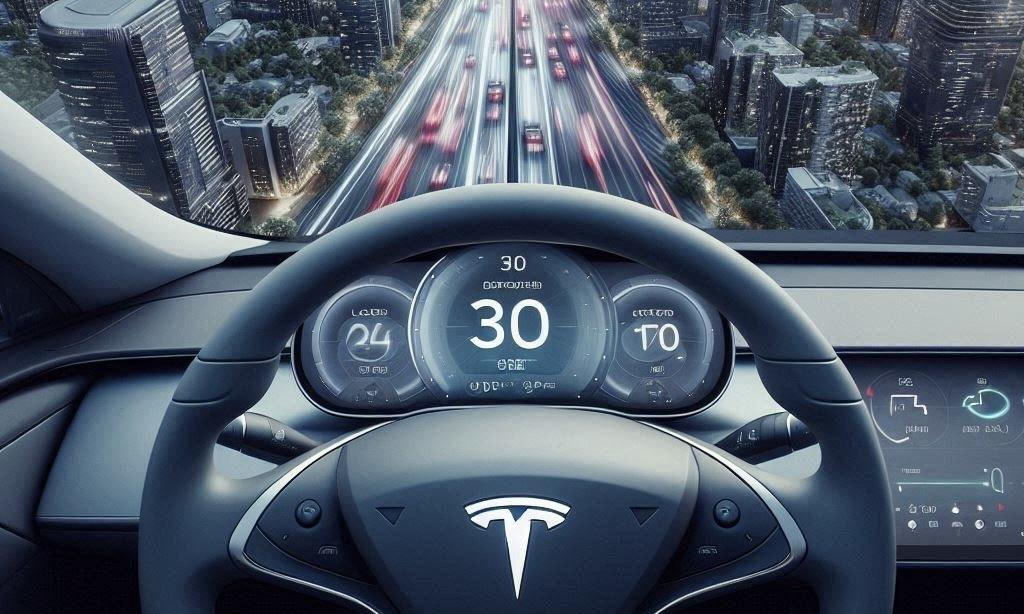Tesla’s Full Self-Driving (FSD) update version 12.5.6.2 now allows speed profiles on roads with speed limits of 50 mph or higher, extending beyond highways to city streets. This feature, part of the 2024.33.30 software update, provides drivers with three modes: Standard, Hurry, and Chill.
Tesla FSD Update Expands Speed Profiles to Roads with Speed Limits of 50 mph and Above
Tesla's Full Self-Driving (FSD) Supervised speed profiles have been modified, allowing the feature to operate on more roadways than before, per Teslarati.
Previously, the capability could only be utilized on highways. Still, Tesla has modified the software in FSD version 12.5.6.2 to enable speed profiles on any road with a speed restriction of 50 mph or above. Ashok Elluswamy, the vice president of AI software at Tesla, verified the information on X this week.
The FSD FSD-supervised version was made available with Tesla software update 2024.33.30. Elluswamy responds that speed profiles had been expanded beyond highways when a user noticed that they could now be used on city streets.
“Speed profiles were extended to 50 mph or higher speed limit roads,” Elluswamy said.
Tesla's Redesigned FSD Modes: Standard, Hurry, and Chill Offer Drivers More Control
Standard, Hurry, and Chill are Tesla's three distinct speed profiles, formerly known as Average and Assertive modes, respectively. Elon Musk stated in June that Tesla would change the modes' names to Standard and Hurry after the company redesigned its FSD drive modes earlier this year.
Drivers in chill mode typically stay in slower lanes and refrain from changing lanes to pass. On the other hand, the Hurry mode provides:
- Quicker.
- Moreover, all driving speeds frequent lane changes to pass.
- A tendency to stay in the fast lane.
On the other hand, the Standard option falls somewhere in the middle, striking a balance between the more incredible speed provided by the Hurry mode and a more laid-back attitude toward lane positions.
Vehicles equipped with Tesla's AI4 computer are anticipated to be the first to receive the software, though cars with the earlier HW3 equipment will probably receive it eventually. Although the FSD speed options aren't yet accessible on roads with speeds lower than fifty miles per hour, the feature may include slower speeds.



 SpaceX Insider Share Sale Values Company Near $800 Billion Amid IPO Speculation
SpaceX Insider Share Sale Values Company Near $800 Billion Amid IPO Speculation  Micron Technology Forecasts Surge in Revenue and Earnings on AI-Driven Memory Demand
Micron Technology Forecasts Surge in Revenue and Earnings on AI-Driven Memory Demand  Oracle Stock Slides After Blue Owl Exit Report, Company Says Michigan Data Center Talks Remain on Track
Oracle Stock Slides After Blue Owl Exit Report, Company Says Michigan Data Center Talks Remain on Track  Trello Outage Disrupts Users as Access Issues Hit Atlassian’s Work Management Platform
Trello Outage Disrupts Users as Access Issues Hit Atlassian’s Work Management Platform  EU Court Cuts Intel Antitrust Fine to €237 Million Amid Long-Running AMD Dispute
EU Court Cuts Intel Antitrust Fine to €237 Million Amid Long-Running AMD Dispute  Biren Technology Targets Hong Kong IPO to Raise $300 Million Amid China’s AI Chip Push
Biren Technology Targets Hong Kong IPO to Raise $300 Million Amid China’s AI Chip Push  Trump Signs Executive Order to Establish National AI Regulation Standard
Trump Signs Executive Order to Establish National AI Regulation Standard  SpaceX Edges Toward Landmark IPO as Elon Musk Confirms Plans
SpaceX Edges Toward Landmark IPO as Elon Musk Confirms Plans  Moore Threads Stock Slides After Risk Warning Despite 600% Surge Since IPO
Moore Threads Stock Slides After Risk Warning Despite 600% Surge Since IPO  Apple App Store Injunction Largely Upheld as Appeals Court Rules on Epic Games Case
Apple App Store Injunction Largely Upheld as Appeals Court Rules on Epic Games Case  SUPERFORTUNE Launches AI-Powered Mobile App, Expanding Beyond Web3 Into $392 Billion Metaphysics Market
SUPERFORTUNE Launches AI-Powered Mobile App, Expanding Beyond Web3 Into $392 Billion Metaphysics Market  Republicans Raise National Security Concerns Over Intel’s Testing of China-Linked Chipmaking Tools
Republicans Raise National Security Concerns Over Intel’s Testing of China-Linked Chipmaking Tools  Australia’s Under-16 Social Media Ban Sparks Global Debate and Early Challenges
Australia’s Under-16 Social Media Ban Sparks Global Debate and Early Challenges  MetaX IPO Soars as China’s AI Chip Stocks Ignite Investor Frenzy
MetaX IPO Soars as China’s AI Chip Stocks Ignite Investor Frenzy 





























